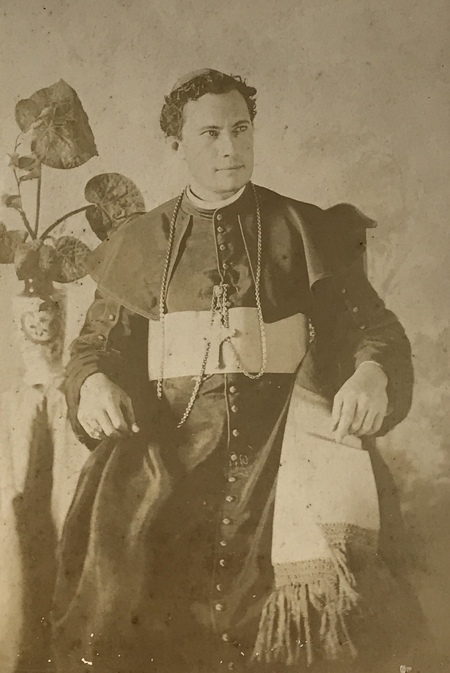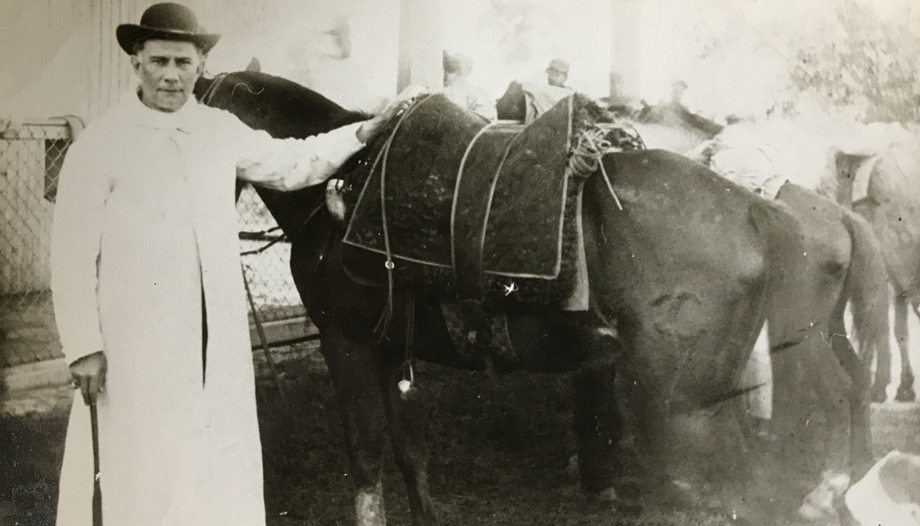Among all the figures that stand out in the wide historical range of Paraguay's history, Monsignor Juan Sinforiano Bogarín (1863-1949). He was born in the very heart of the country and grew up under the dangers of war. From a very young age, he knew how to unite two fundamental rules of Christian discipline: work and prayer. Today we remember him as the Moral Rebuilder of the Paraguayan Nation.
Its origins
He was born on August 21, 1863, in a remote place called Mbuyapey, a rural area along the Tebicuarymí River, about 180 km from Asunción. His childhood was very sad. When he was only three years old, he suffered the terrible war of Paraguay against the Alliance of Argentina, Brazil and Uruguay between 1865 and 1870. His parents died there, leaving him and his two brothers orphaned.
Once the war was over, the Bogarín brothers took refuge in the house of their maternal aunts, the Gonzales sisters, in a town near Asunción and dedicated themselves to farm work. Like almost all his contemporaries, he spoke Spanish and Guarani, a language in which he expressed himself with great force.
Preparing for God's plans
He received very elementary instruction. When the Conciliar Seminary of Asuncion was reopened in 1880, he entered at the age of 17 at the insistence of his brothers.
Pedro Juan Aponte, the diocesan bishop, had entrusted the direction of the seminary to the Fathers of the Mission of St. Vincent de Paul. The new seminary was under the guidance of Father Julio César Montagne, a brilliant formator and, later, a prudent advisor to the young bishop.
Consecrated to God and in love with his country
As soon as he received his priestly consecration in 1886, he was appointed pastor of the cathedral. He immediately gave proof of his organizational efficiency and of his faithful fulfillment of his tasks and obligations. Until 1930 the diocese of Asunción included the entire territory of the country.
With the see of the diocese vacant and exercising the right of patronage, a list of three candidates was presented to the Holy See. Among them was John Symphorian. For this reason he wrote repeatedly asking not to be appointed: ".... I was aware of the many difficulties ahead for the government of the diocese, especially when modern impiety, the fruit of the School without God, began to show its multiform face, and the youth began to look at religion and priests with great concern." (Bogarín, J.S. My notes, p. 19).
He always felt the episcopate as a heavy cross. Much to his regret, he was elected and consecrated on February 3, 1895 by the Salesian bishop, Bishop Louis Lasagna, titular bishop of Tripoli. He was 31 years old.
Preparing the land for cultivation
The young Bishop began a tremendous task. The words disaster, extermination, desolation and the like were not enough to give an accurate and complete picture of the state in which his unfortunate country had been left, a quarter of a century before, at the end of the great war. Such a state had changed little. There was no clergy; neither was there a basic organization, for lack of personnel.
In his heart: God and country
Pro aris et pro focusfor the altar and for the home was his episcopal motto. It sums up his pastoral work and his life. In his mind there was no distinction between missionary work and service to the homeland.
A few months after his consecration, he began his pastoral visits. He wrote in his notes: "Convinced as I was that the religious faith of the faithful was very weak in the diocese, I decided to make pastoral visits, in the form of a true mission, to the towns of the countryside, twice each year. ... From the first year I established the spiritual exercises for the clergy, with half of them attending in one year and the other half in the following year. This disposition caused displeasure and even resistance in some of the older priests, but later they submitted and were very happy with it." (Bogarín, J. S. My notes, p. 37)
Years later - in 1937 - the fruits of this pastoral work of cultivating souls were seen in the celebrations of the first national Eucharistic Congress. It was an impressive demonstration of popular strength and organization of a church that had been rebuilt from its foundations.
Living image of the Good Shepherd, he was called: Angel of Peace, Missionary Apostle, Star of Paraguay, Moral Rebuilder of the nation. He traveled 48,425 km in his pastoral tours; blessed 10,928 marriages; gave 553,067 confirmations; delivered 4055 doctrinal conferences and wrote 66 pastoral letters. His last letters and exhortations, in an atmosphere heated by the post civil war of 1947, were in favor of peace, spiritual disarmament, honesty, honest work and fraternal love.

Pastoral lines
Throughout his episcopal ministry he ordained more than ninety priests. He brought nine institutions of male religious and fourteen of women who did much good to the country. During the 19th century, in addition to the war, the Church was isolated and religious were expelled. There was much, much to be done. It was possible to reach the indigenous people, the formation of urban schools and the care of the poorest and sickest.
Following the guidelines of the Holy See, he wrote a pastoral letter on the danger of Freemasonry; very influential at that time. Secularism was rampant among the more educated classes. It was slandered in various ways and carried it with a Christian and gentlemanly spirit. There were even acts of violence in his house.
In social matters he also succeeded in grouping Catholic workers in religious associations and circles and in unions with great social energy. Faithful to the governing pontiff, he made his visits to the ad limina. He always trusted his collaborators. When in 1898 Pope Leo XIII summoned the bishops of Latin America, he brought his great collaborator Hermenegildo Roa, who was his collaborator throughout his episcopal ministry. Another collaborator was Father Mena Porta, who would be his successor.
Promoter of the laity
He promoted the first associations and movements of lay apostolate that arose in Paraguay. In 1932, the Catholic Action of Paraguay was founded, which since 1941 will have a great impetus thanks to its general director, Father Ramón Bogarin Argaña.
The family was his great concern, and he was even reviled for his insistence on regularizing de facto unions. During his pastoral visits, the "marriages guasú" (multitudinous), were frequent.
"Happy are the peacemakers."
Paraguay lived the first half of the century between revolutions, civil wars and the tragic war with Bolivia. Monsignor Bogarín knew his compatriots and no one better than him was called to bring about the pacification so longed for by the true lovers of the homeland. His opinion was always pacifying, although many times he was not listened to. All the leaders of the political groups had him as a reference.
During the Chaco War (1932-1935), she was the tears of countless Paraguayan mothers. From Bolivia he received voluminous correspondence asking for news and protection for the unfortunate prisoners. None of those letters remained without receiving an autographed reply from the kindly and already elderly Paraguayan archbishop. The Bolivian people in La Paz also received him with great affection when he visited the city several years later. An anecdote reflects his disposition: during the Paraguayan-Bolivian conflict, his elderly sister and other good old ladies washed the bandages used by the wounded in the departments of the metropolitan curia, and the bishop helped in this work.
Pastoral letters
The list of topics in his pastoral letters includes religious teaching in schools, canonical marriage, the Roman pontificate, the practice of religion, some traditional devotions, freedom and brotherhood, catechetical teaching, the Church and politics... With vibrant exhortations on the fulfillment of duties in work and sacrifice, he always accompanied his people in revolts and in war.
But his main pastoral contribution was his self-sacrificing ministry. Suaviter et fortiterHis pastoral activity was as much in his episcopal coat of arms as in his tenor. His priests and closest friends emphasized his intelligence and his congenital gift of personal sympathy, a very pleasant conversationalist and a sparkling conversationalist.
A connoisseur of History and defender of Heritage.
He formed a small museum that was his pride and his most pleasurable occupation in the hours of rest. He liked to exhibit it and to review, with great wealth of details, each one of its pieces. The Monsignor Juan Sinforiano Bogarín Museum is a true relic, an incalculable treasure of the national patrimony of Paraguay, located in an old building of the colonial period, next to the cathedral.
A yearning in progress
Asunción is the mother of cities and its episcopal see dates back to 1567. In 1930 suffragan dioceses were erected: Villarrica and Concepción y Chaco. Mons. Bogarín received the archiepiscopal pallium from the hands of the nuncio.. He died on February 25, 1949 at the age of 86 fruitful years and 54 as bishop. The Paraguayan people mourned the death of a patriarch. In 2020 the diocesan process of beatification of the Servant of God began.
Director of the Ecclesiastical Museum Monsignor Juan Sinforiano Bogarín and executive secretary of the Episcopal Commission for the Cultural Heritage of the Church in Paraguay.








